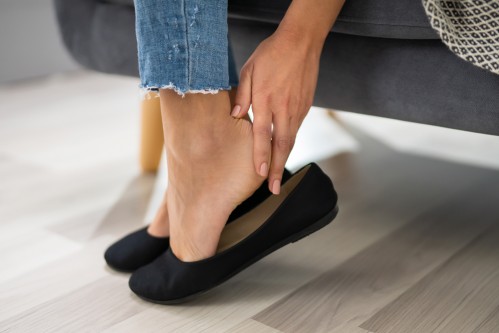
Common Pediatric Foot Concerns
While many pediatric foot concerns do not cause pain or require treatment, some conditions can cause symptoms such as pain, difficulty with shoes, tripping or stumbling, limping, or inability to keep up with peers. Medical evaluation and treatment may be necessary if you notice these symptoms in your child or adolescent.
Toe walking
Toe walking is most common in early childhood and consists of walking on the ball of the foot without the heel contacting the ground. Most children will outgrow toe walking and begin to walk with a normal heel-to-toe gait. When toe walking persists, it can simply be habitual due to tightness in the calves or an underlying condition (neurologic or muscular). Learn more.
Intoeing
Children and adolescents whose feet turn inward while walking or running are commonly referred to as being "pigeon-toed." It typically does not cause pain; most outgrow this by age 8 or 9 with no treatment. Intoeing is the result of a deformity in the foot (metatarsus adductus), shin (tibial torsion), or thigh (femoral anteversion). Learn more.
Flexible Flatfoot
When a flexible flatfoot deformity occurs in a child, it is called "pediatric flatfoot." This condition may be asymptomatic, meaning it causes no pain or disability to the child. If the condition becomes symptomatic, common symptoms include pain, cramping, difficulty with shoes, or fatigue during activity Learn more.
Tarsal Coalition
A tarsal coalition is an abnormal connection between two bones of the foot. This typically becomes symptomatic as the bones mature (age 9-16) and can occur in one or both feet. Symptoms include pain and stiffness, flatfoot deformity, spasm or fatigue of the lower leg muscles, and difficulty with activities. Learn more.
Pediatric Bunions
Although bunions are more common in adults, adolescents may also develop bunions. This condition, also known as pediatric hallux valgus, causes a bump at the base of the big toe. Many pediatric bunions do not cause symptoms or cause mild symptoms that can be managed with properly fitting shoes. Further treatment may be necessary if a pediatric bunion is painful, progresses over time, or restricts activities. Learn more.
Sever's Disease
Sever's Disease, or calcaneal apophysitis, is a common cause of heel pain in active children between the ages of 8 and 14. At this stage in development, the growth plate of the heel bone is subject to inflammation from overuse or repetitive stress. Symptoms include pain and tenderness of the heel, limping or toe walking, and difficulty in sports or other activities. Learn more.
If you're concerned about your child or adolescent's foot or ankle condition, schedule an appointment for them to be evaluated by our foot and ankle specialist.

Related Articles

Foot and Ankle
Avoiding Ankle Injuries in the Snow and Ice
Here in Wisconsin, we are beginning to see our beautiful fall weather turn to snow and ice. Ankle...

Foot and Ankle
Is All Heel Pain the Same?
Heel pain is the single most common problem affecting the foot and ankle, however not all heel pain...

Foot and Ankle
Why Your Ankle Sprain Isn’t Getting Better
Ankle sprains are remarkably common in the United States, with an estimated 27,000 occurring each...

Foot and Ankle
Six Causes of Big Toe Pain
Bunions Also known as hallux valgus, this condition results from the shifting of the bones within...
